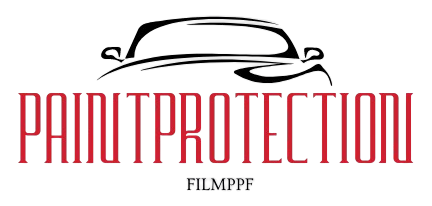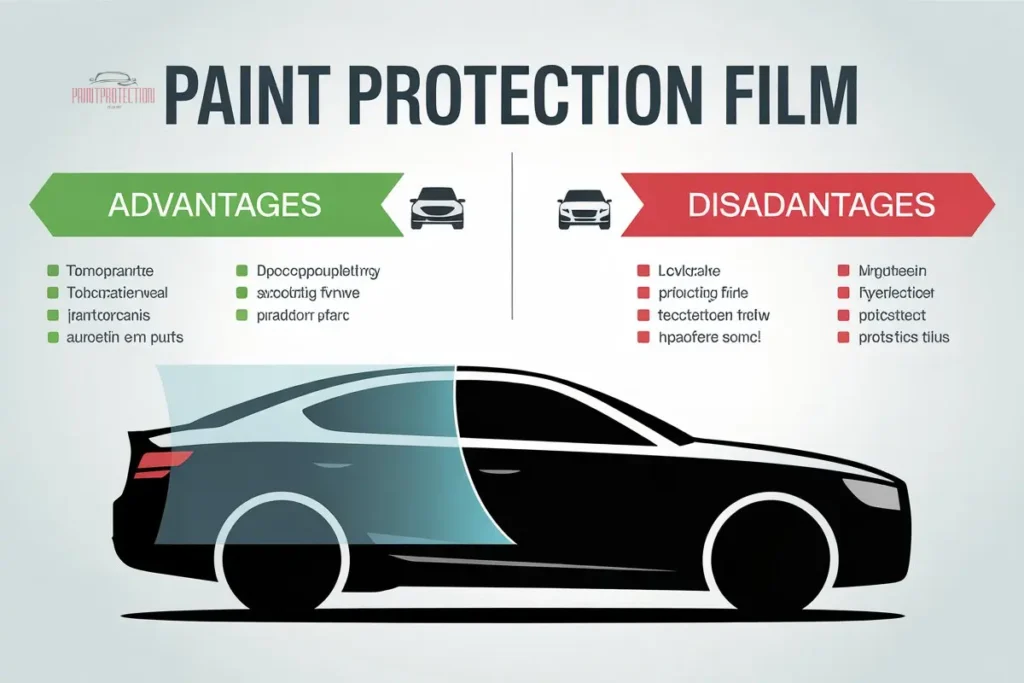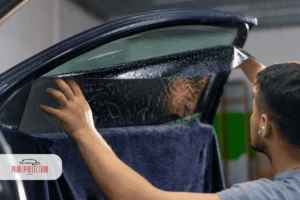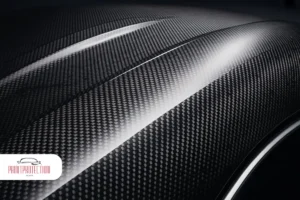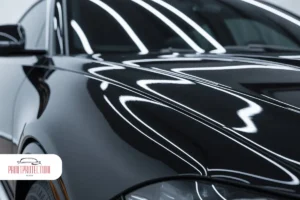When it comes to protecting your vehicle’s paint, understanding the Advantages and Disadvantages of Paint Protection Film is essential. Paint Protection Film (PPF) offers a durable shield against scratches, road debris, & environmental damage. However, like any product, it comes with both benefits & drawbacks that every car owner should consider before investing.
At paintprotectionfilmppf, we aim to provide clear insights into the Advantages of Paint Protection Film & Disadvantages of Paint Protection Film, helping you make an informed decision that preserves your vehicle’s appearance & value.
In this guide, we’ll break down all aspects of Advantages and Disadvantages of PPF, so you can weigh the pros & cons before protecting your car’s paint.
What is Paint Protection Film?
Before diving into the Advantages and Disadvantages of Paint Protection Film, it’s important to understand what Paint Protection Film actually is.
1.1 Definition of Paint Protection Film
Paint Protection Film (PPF) is a thin, transparent layer of thermoplastic urethane that is applied to a vehicle’s exterior surfaces. It acts as a protective barrier against scratches, rock chips, road debris, & minor abrasions, keeping your car’s paint in pristine condition.
1.2 Purpose of Paint Protection Film
The primary purpose of Paint Protection Film is to safeguard your vehicle’s paint from everyday wear & tear. Whether you drive in urban streets or on highways, PPF helps prevent damage that could otherwise lead to costly repairs or repainting.
1.3 Types of Paint Protection Film
There are several types of Paint Protection Film, each designed for specific purposes:
- Clear Bra PPF: Most common, invisible & protects the front of the vehicle.
- Full Vehicle PPF: Covers the entire car for maximum protection.
- Self-Healing PPF: Automatically heals minor scratches with heat exposure.
- Matte & Glossy PPF: Enhances the vehicle’s appearance while providing protection.
Understanding the basics of Paint Protection Film sets the stage for evaluating its Advantages and Disadvantages of PPF, which we will explore in the next sections.
Key Advantages of Paint Protection Film
Understanding the Advantages of Paint Protection Film is crucial for any car owner considering PPF installation. Let’s explore why this protective layer is highly recommended.
2.1 Protection Against Scratches & Chips
One of the primary Advantages of Paint Protection Film is its ability to prevent scratches, stone chips, & minor abrasions caused by everyday driving. Whether it’s loose gravel on highways or accidental brush contact in parking lots, PPF acts as a reliable shield for your car’s paint.
2.2 Preserves Vehicle Value
Vehicles with well-maintained paint retain higher resale value. By investing in Paint Protection Film, you can protect your car from visible damage, ensuring it looks new for longer. This makes PPF a smart choice for those planning to sell or trade their vehicle in the future.
2.3 Self-Healing Technology
Many modern Paint Protection Film options feature self-healing properties. Minor scratches or swirl marks disappear automatically when exposed to heat, such as sunlight or warm water, keeping your vehicle’s paint flawless without extra effort.
2.4 UV Protection
Paint Protection Film offers protection against harmful UV rays, which can cause paint fading over time. By shielding your car from sun damage, PPF ensures your vehicle maintains its original color & finish for years.
2.5 Easy Maintenance
Cleaning a car with Paint Protection Film is easier because dirt, bug splatter, & grime do not stick as easily. The film’s smooth surface allows for effortless washing, saving time & reducing the risk of accidental scratches during cleaning.
2.6 Enhances Aesthetic Appeal
Apart from protection, Paint Protection Film can enhance your car’s appearance. Glossy or matte finishes add a premium look while keeping your vehicle safe, combining style with functionality.
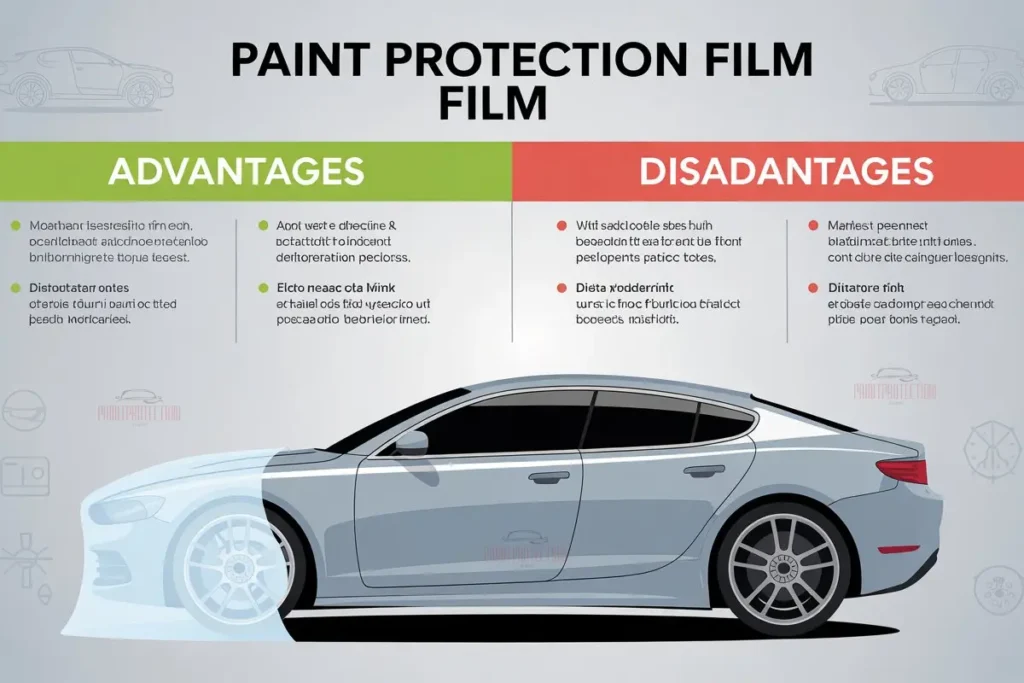
Disadvantages of Paint Protection Film
While there are many benefits, it’s equally important to understand the Disadvantages of Paint Protection Film before making a decision.
3.1 High Initial Cost
One of the main Disadvantages of Paint Protection Film is its upfront cost. Professional installation can be expensive, especially for full-vehicle coverage. However, this investment may be justified by long-term protection & preserved resale value.
3.2 Potential Yellowing Over Time
Some lower-quality Paint Protection Film products may yellow or discolor after prolonged exposure to sunlight. Choosing high-quality PPF from reputable suppliers can minimize this risk and ensure long-lasting clarity.
3.3 Requires Professional Installation
Improper installation of Paint Protection Film can lead to bubbles, wrinkles, or uneven edges. Professional installation is highly recommended, which may add to the overall cost.
3.4 Limited Lifespan
Although durable, Paint Protection Film is not permanent. Depending on driving conditions, quality, & maintenance, PPF may need replacement after 5–10 years. Regular inspection is necessary to maintain optimal protection.
3.5 Not Completely Scratch-Proof
While Paint Protection Film protects against minor scratches, deep scratches or damage from sharp objects can still penetrate the film. It’s essential to understand that PPF is a protective layer, not an invincible shield.
3.6 Removal Can Be Tricky
Removing Paint Protection Film without damaging the underlying paint requires skill. DIY removal is not recommended, as it can lead to peeling or paint damage. Professional removal ensures a safe process but may incur additional cost.
Advantages & Disadvantages of PPF – A Comparative Overview
To make the decision easier, let’s compare the Advantages and Disadvantages of PPF side by side. This summary helps car owners weigh the benefits against potential drawbacks.
| Advantages of Paint Protection Film | Disadvantages of Paint Protection Film |
|---|---|
| Protects against scratches, chips & minor abrasions | High initial cost for quality installation |
| Preserves vehicle resale value | May yellow or discolor over time if low-quality |
| Self-healing technology for minor scratches | Requires professional installation for best results |
| Shields paint from harmful UV rays | Limited lifespan; replacement may be needed after 5–10 years |
| Easier maintenance & cleaning | Not completely scratch-proof against sharp objects |
| Enhances vehicle aesthetics with glossy or matte finishes | Removal can be tricky & may require professional help |
This comparative overview highlights that while Paint Protection Film offers excellent protection & aesthetic benefits, car owners must consider the investment, lifespan, & installation requirements.
By understanding both sides, you can make an informed decision about whether Paint Protection Film is the right choice for your vehicle.
Factors to Consider Before Installing Paint Protection Film
Before deciding on Paint Protection Film, it’s important to evaluate several factors to ensure you get the best results.
5.1 Vehicle Type & Usage
Consider how you use your vehicle. Daily commuters or off-road drivers may benefit more from Paint Protection Film due to higher exposure to scratches, debris, & road hazards. Luxury cars often require full-vehicle PPF for maximum protection.
5.2 Quality of Paint Protection Film
The Advantages and Disadvantages of Paint Protection Film can vary depending on the quality of the product. High-quality PPF lasts longer, resists yellowing, & often includes self-healing properties. Investing in a reputable brand ensures better protection & longevity.
5.3 Installation Expertise
Professional installation is crucial. Poorly applied PPF can lead to bubbles, wrinkles, or peeling. Always choose certified installers to maximize the protective benefits of Paint Protection Film.
5.4 Coverage Area
Decide whether you want partial coverage (front bumper, hood, mirrors) or full-vehicle protection. Partial coverage reduces cost but limits protection, while full coverage maximizes durability & aesthetic appeal.
5.5 Maintenance Requirements
Even though Paint Protection Film makes cleaning easier, it still requires regular care. Avoid abrasive cleaning tools, harsh chemicals, & high-pressure washing to prevent damage. Proper maintenance ensures long-lasting benefits.
5.6 Budget Considerations
While Paint Protection Film is an investment, it can save money in the long run by reducing repainting & repair costs. Balance your budget with the desired level of protection to make the most informed choice.
By considering these factors, you can make a well-informed decision that balances the Advantages and Disadvantages of PPF with your vehicle’s needs.
Tips for Maximizing the Benefits of Paint Protection Film
To fully enjoy the Advantages of Paint Protection Film while minimizing potential drawbacks, it’s essential to follow some practical tips.
6.1 Choose High-Quality Paint Protection Film
Investing in premium Paint Protection Film ensures better durability, resistance to yellowing, & enhanced self-healing capabilities. High-quality PPF also maintains a flawless appearance for years.
6.2 Ensure Professional Installation
Proper installation by certified experts prevents bubbles, wrinkles, & uneven edges. A professional touch maximizes the protective performance & longevity of your Paint Protection Film.
6.3 Regular Cleaning & Maintenance
Clean your vehicle regularly using non-abrasive tools & gentle cleaners. Avoid harsh chemicals & high-pressure washers that can compromise the integrity of the Paint Protection Film.
6.4 Inspect for Damage Periodically
Even with PPF, minor scratches or chips may occur. Inspect the film periodically & address any damage promptly to prevent it from worsening. Early intervention helps maintain both protection & appearance.
6.5 Avoid Harsh Environments When Possible
While Paint Protection Film offers excellent protection, avoid prolonged exposure to harsh elements like acidic rain, saltwater, or extreme heat. These conditions can reduce the film’s lifespan if not properly cared for.
6.6 Consider Full Vehicle Coverage
Partial coverage protects only certain areas, leaving other parts vulnerable. Full-vehicle Paint Protection Film coverage ensures maximum protection, preserving your car’s paint in all conditions.
Following these tips ensures that you fully benefit from the Advantages and Disadvantages of Paint Protection Film, extending the life of your investment while keeping your vehicle looking its best.
Final Thought
Understanding the Advantages and Disadvantages of Paint Protection Film is essential for any vehicle owner who wants to protect their investment. While Paint Protection Film offers superior protection against scratches, chips, UV rays, & minor abrasions, it also comes with considerations like cost, installation requirements, & maintenance.
By weighing the Advantages of Paint Protection Film against the Disadvantages of Paint Protection Film, you can make an informed decision that fits your vehicle’s needs & budget. For those seeking expert advice & quality PPF solutions, paintprotectionfilmppf is a trusted resource to guide you in choosing the right protection for your car.
Invest wisely, maintain your Paint Protection Film properly, & enjoy a vehicle that looks new for years to come – because at paintprotectionfilmppf, we believe every car deserves the ultimate shield.
FAQs
What are the disadvantages of paint protection film?
High cost, potential yellowing, limited lifespan, & requires professional installation.
What are the disadvantages of PPF?
Not completely scratch-proof, may need replacement after several years, & removal can be tricky.
Why is PPF negative?
Low-quality or poorly installed PPF can cause bubbles, discoloration, or paint damage.
Is PPF good or bad for cars?
PPF is generally good, protecting against scratches, chips, & UV damage, though it has some drawbacks.
Is rain bad for PPF?
Rain itself isn’t harmful, but prolonged exposure to harsh conditions or improper cleaning can reduce its lifespan.
